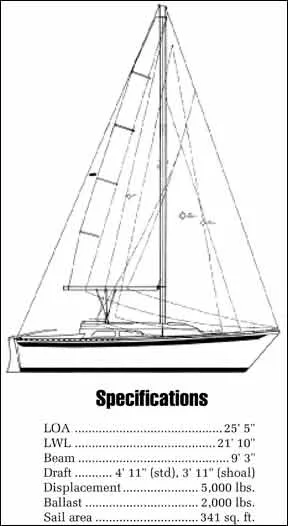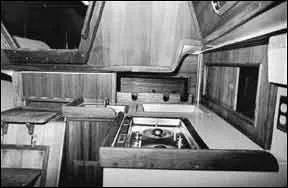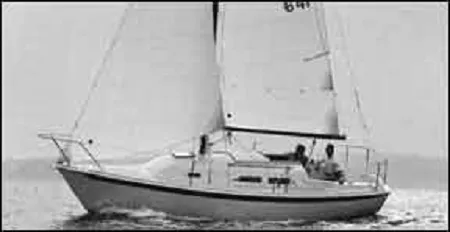Just a few years ago, the prospective buyer of a 25′ sailboat knew that some serious compromises awaited him. His 25-footer would probably have little more than sitting headroom, might have four shelves that could reasonably be called berths, and probably had a head stowed under the forward berth. The galley? With luck, a two-burner alcohol stove, maybe a sink, and a water tank holding ten gallons.
Auxiliary power? Usually a 6 hp outboard hanging off the stern or in a well in the lazarette.
With today’s economy, more and more people who once might have considered a 30-footer are downscaling their size expectations to something more realistic, perhaps a 25- or 27-footer. While they may downgrade their expectations in terms of the length of their boats, they have not downgraded their expectations in terms of the size boat they want. This is not the contradiction it may seem. The fact is that there are a number of boats less than 27′ in overall length that offer room and features akin to those offered in older 30′ boats.
For better or worse, economic reality has forced many of us to downsize our boat expectations in much the way we downsized our automobile expectations.
Then came a new generation of small cruising auxiliaries. The modern 25′ “family” sailboat has 6′ headroom, berths for a family of five—if privacy isn’t a high priority—enclosed head, and perhaps an inboard diesel engine. A regular miniature yacht.
The Ericson 25+ is a good example. The proof of the popularity of this concept shows in the numbers. Over 660 units were built in the first three years after the Ericson 25+ was introduced in late 1978.
Designer Bruce King had a long and successful relationship with Ericson Yachts, starting with the Ericson 23, 30, 32, and 41 of the late 1960s. He has not been exclusively an Ericson “house” designer—witness the magnificent Herreshoff-inspired 90′ ketch Whitehawk to his design—but the vast majority of Ericson boats came from his board.
Bruce King and Ericson found a formula not unlike that of Bill Shaw and Pearson: build a wide range of boats of similar type in two to three foot increments, develop customer loyalty, and watch the customers move up through the ranks. Keep the really popular models, such as the Pearson 35 or the Ericson 35, and bring out other models every few years to catch the latest trend. That formula worked whether you were on the East Coast or the West, and like Pearson, Ericson had the formula down pat.

With the exception of a few forays into the cruising market with the clipper-bowed Cruising 31 and the Cruising 38 (later to be called Independence), the Ericson formula produced a well finished cruiserracer with good sailing characteristics. The Ericson 25+ was part of this successful formula.
Construction
The hull of the Ericson 25+ is a solid hand layup. A molded fiberglass body pan is glassed to the inside of the hull, functioning as the base for much of the interior furniture and adding a certain amount of rigidity to the hull. The deck, cockpit, and cabin trunk molding is balsa cored, with plywood replacing the balsa in high stress areas such as under the deck-stepped mast and where deck hardware is mounted.
Exterior glasswork is of good quality, with little roving printthrough, Gelcoat work is good.
The hull-to-deck joint depends on a secondary chemical bond. Both the hull and deck have an external molded flange. Glass-reinforced polyester resin is used as a bedding compound between these flanges. The inside of this joint is then lapped with four layers of fiberglass mat and cloth. This joint is covered on the outside by a plastic extrusion with a soft plastic insert which functions as a rub rail. We prefer a mechanically fastened hull-to-deck joint, because the strength of secondary chemical bonds is very difficult to evaluate.
The deck of the 25+ has a remarkably solid feel thanks to its cored construction. Neither the deck, cockpit, nor cabin top had any of the sponginess frequently associated with small boats.
Deck hardware of the 25+ is well mounted. Stanchions, pulpits, cleats, and winches have adequate aluminum bearing plates. The tiller head is a substantial chrome-plated bronze casting, The transom is plywood cored, greatly adding to its rigidity.
The mast of the 25+ is a black, deck-stepped extrusion. The stainless steel mast step looks surprisingly fragile. Because the mast is designed to be owner-stepped if desired, the forward lower half of the base of the mast is cut away to allow the mast to pivot forward for lowering. We doubt if there are many owners who will step their own masts. The design of the mast step to facilitate raising and lowering has greatly reduced the bearing surface of the heel of the mast.
In contrast to the mast step, the shroud chainplates are of surprisingly heavy construction. The 25+ utilizes Navtec chainplates, shroud terminals, and turnbuckles. Chainplates are strongly tied to the hull.
All through hull fittings below the waterline have Zytel valves, a reinforced plastic. Most have double-clamped hoses, but the icebox drain hose has a single clamp. Although modern plastics are strong, we suggest that you carefully inventory through hull fittings, as they are a major culprit in many sinkings of otherwise undamaged boats. Plastic valves may be immune to electrolysis, but they cannot be forgotten any more than bronze seacocks can be ignored.

Handling Under Sail
Despite the chubbiness of the 25+, owners report that she is a fast boat under sail. There are a number of features that contribute to this speed, She has minimum wetted surface, despite a displacement that is average for her overall length, though fairly light for a waterline length of almost 22′.
The Ericson 25+, 28+, and 30+ all feature Bruce King’s trademark, the “delta” fin keel. King states that this keel form has very low induced drag, and the 25’s performance reinforces his belief. The optional shoal draft keel reduces draft a foot, reduces lateral plane, and no doubt reduces windward ability, Unless you are bound and determined to have a boat drawing under four feet, by all means get the deeper draft version.
The rig of the 25+ is a high aspect ratio 7/8 sloop rig. The mainsail hoist of 31.5′ is unusual for a 25′ boat. In light air, tall rigs are usually faster, and we would expect the boat’s best point of sail to be upwind in light air. Since a great deal of the sailing in the world seems to be upwind in light air, this approach to the rig is a rational one.
With the addition of a backstay adjuster—easy because of the split backstay—it is possible to induce a reasonable amount of mast bend to control sail shape. A full width mainsheet traveler mounted on the cockpit bridgedeck greatly enhances mainsail control.
Shroud chainplates are set well inboard, allowing narrow headsail sheeting angles. The genoa track is also located inboard, almost against the cabin side.
There is no main boom topping lift, We think this is pretty indefensible on a cruising boat, and despite the additional windage, a topping lift is greatly to be desired on a racing boat. Without a topping lift, reefing becomes a real exercise in agility. Dropping the mainsail is greatly complicated, especially when cruising shorthanded. Should the main halyard break when sailing close hauled, the main boom could brain anyone sitting on the leeward side of the cockpit.
Two-speed Barient headsail sheet winches were standard in later boats. There is room on the cockpit coamings both for the addition of secondary winches for spinnaker handling and the replacement of the standard winches with larger ones. A single halyard winch is mounted on the mast, There is no main halyard winch. We would choose the optional aftleading halyards to facilitate shorthanded cruising.
The 25+ should sail with almost any other production cruiser-racer of her size. Her wide beam and deep draft should offset the additional heeling moment of the tall rig. Like all wide modern boats she should be sailed on her feet. Get the crew weight out on the weather rail in a breeze, and she should carry sail well.
Handling Under Power
There were probably more power options for the 25+ than any similar-sized boat on the market. They included: outboard power, OMC gas saildrive, Volvo diesel saildrive, and Yanmar diesel inboard.
The 25+ is small enough to be driven fairly well by a 10-hp outboard. There was about a $3,500 difference in equipping the boat with an outboard engine versus the diesel inboard. The choice depended largely on how the boat was to be used. Few boats of this size are used for long-distance cruising. For daysailing and racing, an outboard engine is more than adequate.
If extended coastal cruising is to be the boat’s primary activity, then one of the inboard options should be considered. Frankly, we have little love for saildrive installations. If you really want an inboard engine, the Yanmar single cylinder inboard diesel is the real choice. No matter which engine is in the boat, it is equipped with a 20-gallon aluminum fuel tank.
With a one-cylinder diesel engine, given a fourknot cruising speed and fuel consumption of about 1/4 gallon per hour, the range under power is almost 350 miles—a truly astounding range for a 25′ boat, That’s probably more range under power than the average boat is likely to need for an entire season.
Deck Layout
With shroud chainplates set well inboard, and a reasonably narrow cabin trunk, working on the deck of the 25+ is fairly easy. There is adequate room between the shrouds and the lifelines to walk outboard of the shrouds with ease.
There is a small foredeck anchor well, adequate for the stowage of a single Danforth and rode. There are no bow chocks, but there are two cleats located forward at the outboard edge of the deck.
Molded-in nonskid of a color contrasting to the primary deck color was standard on the Ericson. This relieves eyestrain in bright sunlight and reduces the basically austere external appearance of the boat.
The cockpit of the 25+ is comfortable. Coamings are angled outward rather than being vertical, allowing a more natural sitting posture. As in most tiller-steered boats, the sweep of the tiller occupies a large percentage of the cockpit volume. In port, the tiller swings up and out of the way, providing un-crowded seating for up to six adults.

A single cockpit scupper 1—1/ 2″ in diameter is recessed in a well at the back of the cockpit. The well allows water to drain on either tack. A stainless steel strainer over the scupper reduces its effective area by over 50%. Since the drain size is large enough to pass on through almost any debris that is likely to be found in the cockpit, we would remove the strainer for sailing. A single 1-1/2″ diameter scupper has more cross sectional area than two 1″ drains, and is less likely to clog.
There are two cockpit lockers. The starboard cockpit locker is a shallow pan suitable for storing small items such as winch handles and sail ties. At its after corner is a deeper bin which could make a handy icebox for cold drinks. The port locker is a large, deep affair which unfortunately suffers from the common failing of not being adequately separated from the under-cockpit area, A snap-in Dacron bag would convert this locker to reasonable sail stowage.
The companionway uses thick, well-made solid teak dropboards with proper step joints to prevent spray from working below, Unfortunately, the very strong taper to the companionway slides allows them to be removed by lifting less than an inch. For sailing in rough water, a positive means of securing these slides—a sliding bolt, for example—must be installed.
It is gratifying to see a real bridgedeck in a boat this size. Except for the strong taper to the companionway sides, this is one of the best designed cockpits we have seen in a small boat.
Belowdecks
The amount of interior volume in the 25+ is truly remarkable. The boat easily has the headroom and elbow room of most older 30-footers.
The forepeak contains the usual V-berth with a filler to form a nominal double. We truly mean nominal. Two normal-sized people simply do not fit in the forward berth of the Ericson 25+. Consider it a large single instead, or a double for two children. Water and holding tanks occupy the space under the berth.
The 25+ has a genuine enclosed, standup head, an almost unheard of luxury in a boat this size. The head has an opening port for ventilation. There are two small lockers in the head, but both are largely occupied by plumbing hoses.
Opposite the head is a small hanging locker. This locker is fully lined with teak plywood, a nice finishing touch.
It is in the main cabin that the 25+ really shines. Headroom is an honest 6′. Two comfortable settee berths seat 6 in comfort, A fold-down drop-leaf table is big enough to serve 4, and is one of the sturdier tables of this type that we have seen.
The main cabin of the 25+ is well finished with a combination of off-white fiberglass and teak. This is a very successful decorating job, without so much teak as to turn the interior into a cave but with enough to give a well finished appearance. A ceiling of teak strips became standard later on in the production run, and the cabin trunk sides are veneered in teak. A teak and holly cabin sole came standard, with two access hatches to the bilge.
There is a real bilge, unusual in a boat of this size. The strainer for the cockpit-mounted Whale Gusher pump is accessible through a cabin sole hatch.
Under the settee on each side of the cabin there are storage bins. These make use of molded polyethylene drop-in liners, a most practical solution which recognizes the reality that under-seat storage is rarely, if ever, completely dry. An optional extension to the starboard settee converts it to a double berth, but at the expense of easy access to the storage bins underneath.
The galley is surprisingly complete for a 25′ boat. There is a well-insulated icebox of five cubic foot capacity. The insulation is exposed in the port cockpit locker, and will be vulnerable to damage from items stowed there. It could easily be sealed off with either plywood or fiberglass to protect it. The icebox lid is an uninsulated molding advertised as a removable serving tray. If it is used as a serving tray, then the icebox is uncovered, allowing the ice to melt. Whoever thought up that bright idea should go back to the drawing board or look around for some common sense.
For some reason, icebox lids are one of the poorest design features of most sailboats, It’s quite remarkable on boats with otherwise thoughtful design and construction to see poor icebox design. Perhaps there is collusion between the Union of Icebox Designers and the Association of Manufacturers of Ice to maximize the consumption of ice aboard sailboats.
There are storage lockers both above and below the icebox-stove counter. The stove is a recessed Kenyon two-burner alcohol unit with a cutting block cover, These stoves have the fuel fill located between the two burners, and we feel they are a poor choice for use aboard a boat. The burners must be absolutely cool before the fuel tank is filled to eliminate the possibility of explosion or fire.

It is not necessary to step on the galley counter when coming down the companionway. This is a real plus. Footprints on the counters have never appealed to us.
A human-sized quarterberth is a welcome feature. With adequate headroom over, it eliminates the coffinlike aura of so many small-boat quarterberths, and is without a doubt the roomiest, most comfortable berth on the boat.
With an outboard engine, the room under the cockpit that would normally house an inboard is given over to storage. The tiny one-cylinder Yanmar diesel would easily shoehorn into the same space.
Without a doubt, the interior of the Ericson 25+ is a real accomplishment, It is well finished, generally well designed, and remarkably roomy for a boat of this overall length. There is some miniaturization of components, such as the galley sink, head sink, and hanging locker. Nonetheless, she’s a big little boat, and would be truly comfortable for extended coastal cruising for a couple. That is something that can rarely be said for a 25′ boat.
Conclusions
Ericson came very close to achieving their goals in the 25+. She is about as much boat as can be crammed into this overall length.
An interesting option is an E-Z Loader trailer. With a beam of over 9′ and a weight of 5,000 pounds, the 25+ is no trailer sailer. It takes a large, powerful car or truck to tow a boat of this size, and the beam could present legal problems in some states. The trailer would be most useful for taking the boat home for winter storage, rather than frequent over-the-road transport.
Workmanship and finish detail are generally of good stock boat quality. Exposed joiner work is good. Fillet bonding varies from good to only fair, with glasswork generally good.
The Ericson 25+ is a good small cruiser for a young family, and offers enough sailing performance to be a reasonable choice for club racing.
Unlike many small cruiser-racers which concentrate on interior volume and forsake sailing ability, the 25+ really will sail. This means that the new sailor will not quickly outgrow her as he or she learns what makes a boat go fast. With good hardware such as Barient and Navtec and a fairly high degree of finish detail, it is easy to see why the boat fetches the prices it does.
For those used to less-expensive 25-footers, the cost will be a shock. It helps a little to think of her as a 28-footer with the stern cut off.
With an inboard diesel, a good light air rig, and lots of interior volume, she’s a good little cruising boat for a couple. A maximum boat for minimum length, she’s a modern solution to skyrocketing costs of sailing. At maximum price for her length when new, she’s not an example of “more for less,” but then, there’s no free lunch in the sailboat market. That’s for sure.

































